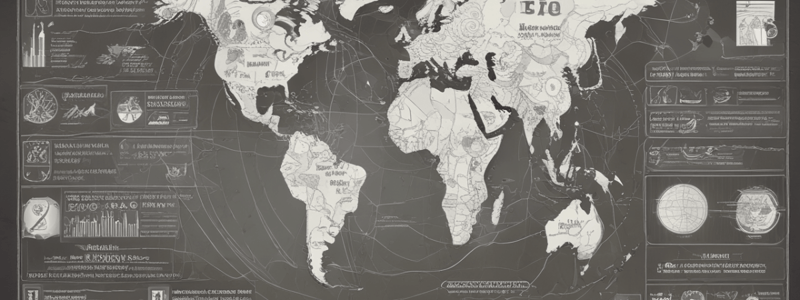Podcast
Questions and Answers
What is the average life expectancy in Japan?
What is the average life expectancy in Japan?
- 79 years
- 82 years
- 66 years
- 84 years (correct)
What is a major factor contributing to the difference in life expectancy across countries?
What is a major factor contributing to the difference in life expectancy across countries?
- Access to healthcare (correct)
- Access to transportation
- Access to technology
- Access to education
Which of the following countries has the lowest life expectancy?
Which of the following countries has the lowest life expectancy?
- Angola (correct)
- India
- Congo
- France
What is the term used to describe the uneven distribution of wealth and resources globally?
What is the term used to describe the uneven distribution of wealth and resources globally?
What is the purpose of drawing a champagne glass when discussing global inequality?
What is the purpose of drawing a champagne glass when discussing global inequality?
What percentage of people in Central and Western Africa may not have access to clean water?
What percentage of people in Central and Western Africa may not have access to clean water?
What is the average life expectancy in the US?
What is the average life expectancy in the US?
What is an example of a country with high life expectancy?
What is an example of a country with high life expectancy?
What percentage of global income does the richest fifth have?
What percentage of global income does the richest fifth have?
What percentage of global income does the poorest fifth have?
What percentage of global income does the poorest fifth have?
What percentage of global income do the middle 60% have?
What percentage of global income do the middle 60% have?
How many people have more wealth than the poorest 3.5 billion people?
How many people have more wealth than the poorest 3.5 billion people?
What is the maternal mortality rate in Northern Europe and America?
What is the maternal mortality rate in Northern Europe and America?
What is the maternal mortality rate in Central and Western Africa?
What is the maternal mortality rate in Central and Western Africa?
What is the ratio of the maternal mortality rate in Central and Western Africa to that in Northern Europe and America?
What is the ratio of the maternal mortality rate in Central and Western Africa to that in Northern Europe and America?
What does the champagne glass analogy represent?
What does the champagne glass analogy represent?
What is the main idea behind using the champagne glass analogy?
What is the main idea behind using the champagne glass analogy?
What is the significance of the maternal mortality rate in healthcare?
What is the significance of the maternal mortality rate in healthcare?
What is the approximate ratio of the richest fifth's global income to the poorest fifth's global income?
What is the approximate ratio of the richest fifth's global income to the poorest fifth's global income?
Which region has the highest maternal mortality rate?
Which region has the highest maternal mortality rate?
What is a common characteristic of countries with great inequalities in wealth?
What is a common characteristic of countries with great inequalities in wealth?
What is the primary reason for using the maternal mortality rate as a marker for healthcare systems?
What is the primary reason for using the maternal mortality rate as a marker for healthcare systems?
What is the approximate ratio of the richest fifth's global income to the poorest fifth's global income?
What is the approximate ratio of the richest fifth's global income to the poorest fifth's global income?
What is the common characteristic shared by countries with great inequalities in wealth?
What is the common characteristic shared by countries with great inequalities in wealth?
What is the significance of the 70-fold increase in maternal mortality rate between Northern Europe/America and Central/Western Africa?
What is the significance of the 70-fold increase in maternal mortality rate between Northern Europe/America and Central/Western Africa?
What is the primary implication of the richest 85 people having more wealth than the poorest 3.5 billion people?
What is the primary implication of the richest 85 people having more wealth than the poorest 3.5 billion people?
Study Notes
Global Inequality
- The world is an unequal place, with significant variations in life expectancy across countries, ranging from 51 years in Angola and 52 years in the Congo to 84 years in Japan.
Life Expectancy
- Life expectancy is influenced by access to food, healthcare, vaccinations, and clean water and sanitation.
- India has an average life expectancy of 66 years.
- France and Japan have some of the highest life expectancies, while Angola and the Congo have some of the lowest.
Access to Clean Water
- In the US and Europe, almost everybody has access to clean water.
- In Central and Western Africa, access to clean water is difficult for a substantial number of people, with up to a third of the population lacking access.
Global Income Inequality
- The richest fifth of the global population hold 82.7% of global income.
- The poorest fifth hold only 1.4% of global income.
- The middle 60% of the population hold less than 16% of global income.
Wealth Inequality
- The richest 85 people have more wealth than the poorest 3.5 billion people in the world.
- There are significant wealth disparities within countries, with rich and poor individuals existing alongside each other.
Maternal Mortality Rate
- The maternal mortality rate is a key indicator of healthcare system effectiveness.
- The rate varies significantly across regions, with:
- 10-20 per 100,000 women dying in childbirth in Northern Europe and America.
- 75 per 100,000 in South America.
- 170 per 100,000 in Southeast Asia.
- 700 or more per 100,000 in Central and Western Africa.
Global Inequality
- The world is an unequal place, with significant variations in life expectancy across countries, ranging from 51 years in Angola and 52 years in the Congo to 84 years in Japan.
Life Expectancy
- Life expectancy is influenced by access to food, healthcare, vaccinations, and clean water and sanitation.
- India has an average life expectancy of 66 years.
- France and Japan have some of the highest life expectancies, while Angola and the Congo have some of the lowest.
Access to Clean Water
- In the US and Europe, almost everybody has access to clean water.
- In Central and Western Africa, access to clean water is difficult for a substantial number of people, with up to a third of the population lacking access.
Global Income Inequality
- The richest fifth of the global population hold 82.7% of global income.
- The poorest fifth hold only 1.4% of global income.
- The middle 60% of the population hold less than 16% of global income.
Wealth Inequality
- The richest 85 people have more wealth than the poorest 3.5 billion people in the world.
- There are significant wealth disparities within countries, with rich and poor individuals existing alongside each other.
Maternal Mortality Rate
- The maternal mortality rate is a key indicator of healthcare system effectiveness.
- The rate varies significantly across regions, with:
- 10-20 per 100,000 women dying in childbirth in Northern Europe and America.
- 75 per 100,000 in South America.
- 170 per 100,000 in Southeast Asia.
- 700 or more per 100,000 in Central and Western Africa.
Global Inequality
- The world is an unequal place, with significant variations in life expectancy across countries, ranging from 51 years in Angola and 52 years in the Congo to 84 years in Japan.
Life Expectancy
- Life expectancy is influenced by access to food, healthcare, vaccinations, and clean water and sanitation.
- India has an average life expectancy of 66 years.
- France and Japan have some of the highest life expectancies, while Angola and the Congo have some of the lowest.
Access to Clean Water
- In the US and Europe, almost everybody has access to clean water.
- In Central and Western Africa, access to clean water is difficult for a substantial number of people, with up to a third of the population lacking access.
Global Income Inequality
- The richest fifth of the global population hold 82.7% of global income.
- The poorest fifth hold only 1.4% of global income.
- The middle 60% of the population hold less than 16% of global income.
Wealth Inequality
- The richest 85 people have more wealth than the poorest 3.5 billion people in the world.
- There are significant wealth disparities within countries, with rich and poor individuals existing alongside each other.
Maternal Mortality Rate
- The maternal mortality rate is a key indicator of healthcare system effectiveness.
- The rate varies significantly across regions, with:
- 10-20 per 100,000 women dying in childbirth in Northern Europe and America.
- 75 per 100,000 in South America.
- 170 per 100,000 in Southeast Asia.
- 700 or more per 100,000 in Central and Western Africa.
Studying That Suits You
Use AI to generate personalized quizzes and flashcards to suit your learning preferences.
Description
This quiz compares the average life expectancy of different countries, highlighting significant disparities between nations like Japan, France, and the US, versus Angola, Congo, and India.




